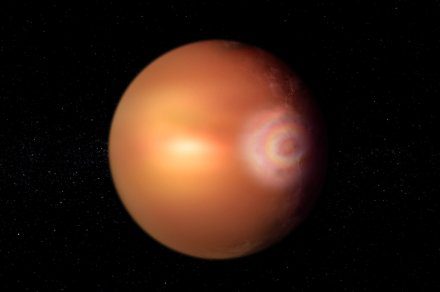Simply from our personal photo voltaic system, we will see that planets are available all kinds of colours — from the dusty purple of Mars to the brilliant blues of Uranus and Neptune. Planets like Jupiter have lovely bands of coloration attributable to variations within the ambiance, whereas it’s exhausting to even see the floor of Venus as a result of its ambiance is so thick. However there are different variations in coloration which planets can show, like a shocking rainbow-hued set of round rings referred to as a glory.
Glories are noticed on Earth, and have been seen simply as soon as on one other planet, Venus. However now, researchers consider they might have recognized a glory on a planet exterior our photo voltaic system for the primary time. The acute exoplanet WASP-76b could possibly be host to the primary identified extrasolar glory, noticed by the European Area Company (ESA)’s Characterising ExOplanet Satellite tv for pc (Cheops).
For the primary time, potential indicators of the rainbow-like ‘glory impact’ have been detected on a planet exterior our Photo voltaic System. Glory are colourful concentric rings of sunshine that happen solely beneath peculiar situations. Knowledge from ESA’s delicate Characterising ExOplanet Satellite tv for pc, Cheops, together with a number of different ESA and NASA missions, recommend this delicate phenomenon is beaming straight at Earth from the hellish ambiance of ultra-hot fuel large WASP-76b, 637 light-years away. ESA. Work carried out by ATG beneath contract for ESA
“There’s a cause no glory has been seen earlier than exterior our Photo voltaic System – it requires very peculiar situations,” mentioned lead writer of the analysis, Olivier Demangeon of the Instituto de Astrofísica e Ciências do Espaço in a press release. “First, you want atmospheric particles which are close-to-perfectly spherical, utterly uniform and secure sufficient to be noticed over a very long time. The planet’s close by star must shine immediately at it, with the observer – right here Cheops – at simply the correct orientation.”
The glory impact happens when gentle bounces off clouds in a planet’s ambiance, although it’s not clear what substance the clouds could possibly be composed of for this to occur. The clouds would wish to have spherical droplets and to be secure over time.
WASP-76b is already well-known as an excessive exoplanet, with an environment heated to a scorching 2,000 levels Celsius, which is so scorching it rains iron there. The planet is tidally locked, which means one aspect of it all the time faces its star and one aspect all the time faces out into area, inflicting a large temperature distinction between these two sides. Additionally it is puffed as much as an enormous measurement given its mass.
Despite the fact that the planet is properly studied, it’s nonetheless very exhausting to see particulars of what’s occurring there, as it’s positioned over 600 light-years away. Researchers warn that it’s exhausting to make sure that what’s being seen is actually a glory impact.
“What’s vital to remember is the unimaginable scale of what we’re witnessing,” mentioned Matthew Standing, an ESA Analysis Fellow learning exoplanets. “WASP-76b is a number of hundred light-years away – an intensely scorching fuel large planet the place it possible rains molten iron. Regardless of the chaos, it seems to be like we’ve detected the potential indicators of a glory. It’s an extremely faint sign.”
The indications have exoplanet scientists intrigued, nevertheless, as they may assist to make clear this planet’s dramatic ambiance. “Additional proof is required to say conclusively that this intriguing ‘additional gentle’ is a uncommon glory,” mentioned Theresa Lüftinger, Challenge Scientist for ESA’s upcoming Ariel mission. “Comply with-up observations from the NIRSPEC instrument onboard the NASA/ESA/CSA James Webb Area Telescope may do exactly the job. Or ESA’s upcoming Ariel mission may show its presence. We may even discover extra gloriously revealing colours shining from different exoplanets.”
Editors’ Suggestions









